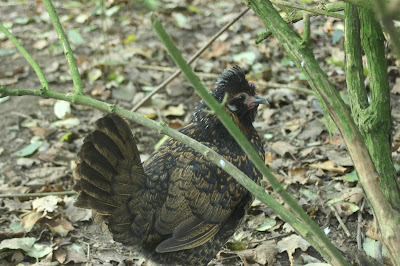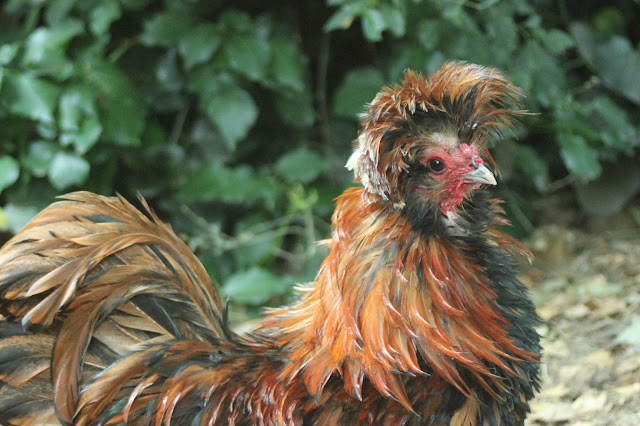'A whistling woman, crowing hen are neither fit for God nor men' Old Scottish proverb
'Power corrupts and absolute power corrupts absolutely ' Lord Acton (1834–1902)
Well
much to my chagrin I've never been able to whistle but just recently
I've acquired a hen who can crow beautifully! Maybe acquired is not
quite the correct verb to use, she's been with us for many a year,
Chocolatine, a Polish cross who has already featured as the main player
in my film 'Why do hens go broody?' (film still below) I'll post it at
the end of this piece just to show you what she looks like on a
reasonably normal day.
I
thought it would be a good starting point from which to discuss group
dynamics and the issues which may arise when keeping several flocks of
birds within a forest garden environment. It may also be useful to people with single sex flocks who may be experiencing difficulties with super-dominant/omnipotent birds. I shall also look at the strategies I have used when confronted with various issues, such as bullying and learned helplessness. I'm taking actual examples of specific hens and cockerels in my flocks, so I'm going to split this article into three parts, otherwise it would become unwieldy and unreadable!
The Backstory
Firstly however, I must just state that, from my observation, the nature of flock dynamics is so complex and fluid that I don't think a mere human brain could ever totally get to grips with it. Many thousands of years ago, man took an essentially wild male bird from its roost in the trees, in order to carry out a form of 'sport' known as cock fighting. Even that was subject to human modification, for if you've ever seen two male birds fight, it is, a subtle blend of ritual, theatre, mesmerism and often courtship, in most cases with
no physical contact. Over time the female was also taken to provide eggs for food and placed in an environment, housed and fed to suit the keeper rather than the kept. Fast forward to World War One and the glimmerings of industrial agriculture, where draconian dictates housed poultry in ever diminishing space and stripped them of so much of their natural behaviours that I'm amazed they retain even a vestige of their ancestry. It is a testament to these birds' physical and mental strength that you can put a battery hen out in a field and watch her peel back that year of servitude the minute she scratches the earth.
The Crested Polish was originally brought to Britain by the Romans. A champion forager, great layer, independent character, who could survive the coldest of Winters. It was amongst the first of so many of what are now called rare or heritage breeds to be side-lined almost to extinction in the 1950s. This, in favour of the fair-weather, docile Italian Leghorn who could lay like a machine and seemingly manage to just exist in the confines of the caged battery system. Spike above, is a golden, crested and bearded, black-laced, frizzled Polish, the frizzled gene also seems to impact on the personality of the bird. In most of our chicken coops the frizzled birds, male and female, are dominant.
 I remember my father saying to me and on so many occasions, that farming was a totally unnatural business but I have in my own and very small way tried to bring something of the jungle back to my birds. However, as Gertrude Jekyll wrote with reference to wilderness gardening, it is so much harder to create a natural environment than a formal one. This problem lies at the very heart of how birds actually live and what we as humans really understand by that. We've so much bent poultry to our own will and needs and I am sure, funded research to support the premiss, that I'm convinced that what we really need to do is to throw everything out
and start again.
I remember my father saying to me and on so many occasions, that farming was a totally unnatural business but I have in my own and very small way tried to bring something of the jungle back to my birds. However, as Gertrude Jekyll wrote with reference to wilderness gardening, it is so much harder to create a natural environment than a formal one. This problem lies at the very heart of how birds actually live and what we as humans really understand by that. We've so much bent poultry to our own will and needs and I am sure, funded research to support the premiss, that I'm convinced that what we really need to do is to throw everything out
and start again.Over the years of observing my poultry I've come to the conclusion that large flocks of single sex birds usually hens living with one cockerel is not the way to go. My poultry live in a group yes, but they live in small groups and within those they can quite happily exist in couples, as friends and family units.
 I now want to show you what Chocolatine looks like normally or rather, when broody and quite vocal. Broodiness and subsequent motherhood seems to me, crucial to a hen as a stepping off point towards being dominant within her individual flock. As you will see at the end of this series, with Chocolatine, this process went much further. Her main problem however was with timing, for if you want to be dominant you have to look the part, unfortunately Chocolatine was well into a heavy moult by the time her chance came. She's looking a lot better today, less ragged around the edges but still keeping a low profile! I also perhaps thought that you might not believe it was the same hen when you saw her later at the end of the series.
I now want to show you what Chocolatine looks like normally or rather, when broody and quite vocal. Broodiness and subsequent motherhood seems to me, crucial to a hen as a stepping off point towards being dominant within her individual flock. As you will see at the end of this series, with Chocolatine, this process went much further. Her main problem however was with timing, for if you want to be dominant you have to look the part, unfortunately Chocolatine was well into a heavy moult by the time her chance came. She's looking a lot better today, less ragged around the edges but still keeping a low profile! I also perhaps thought that you might not believe it was the same hen when you saw her later at the end of the series.Now if you'd like to sit back and watch the film, where I will try to answer the question - why do hens go broody?
Part Two, Family groups, monogamy, friendships, power struggles and gangs can be found through this live link here
Thanks for dropping by and if you
have enjoyed this piece and found it useful think about sharing it and
also may be about joining this blog. Please also feel free to ask
questions or make comments in the section below.
All the very best,Sue
RETURN TO CONTENTS PAGE
© Sue Cross 2015





